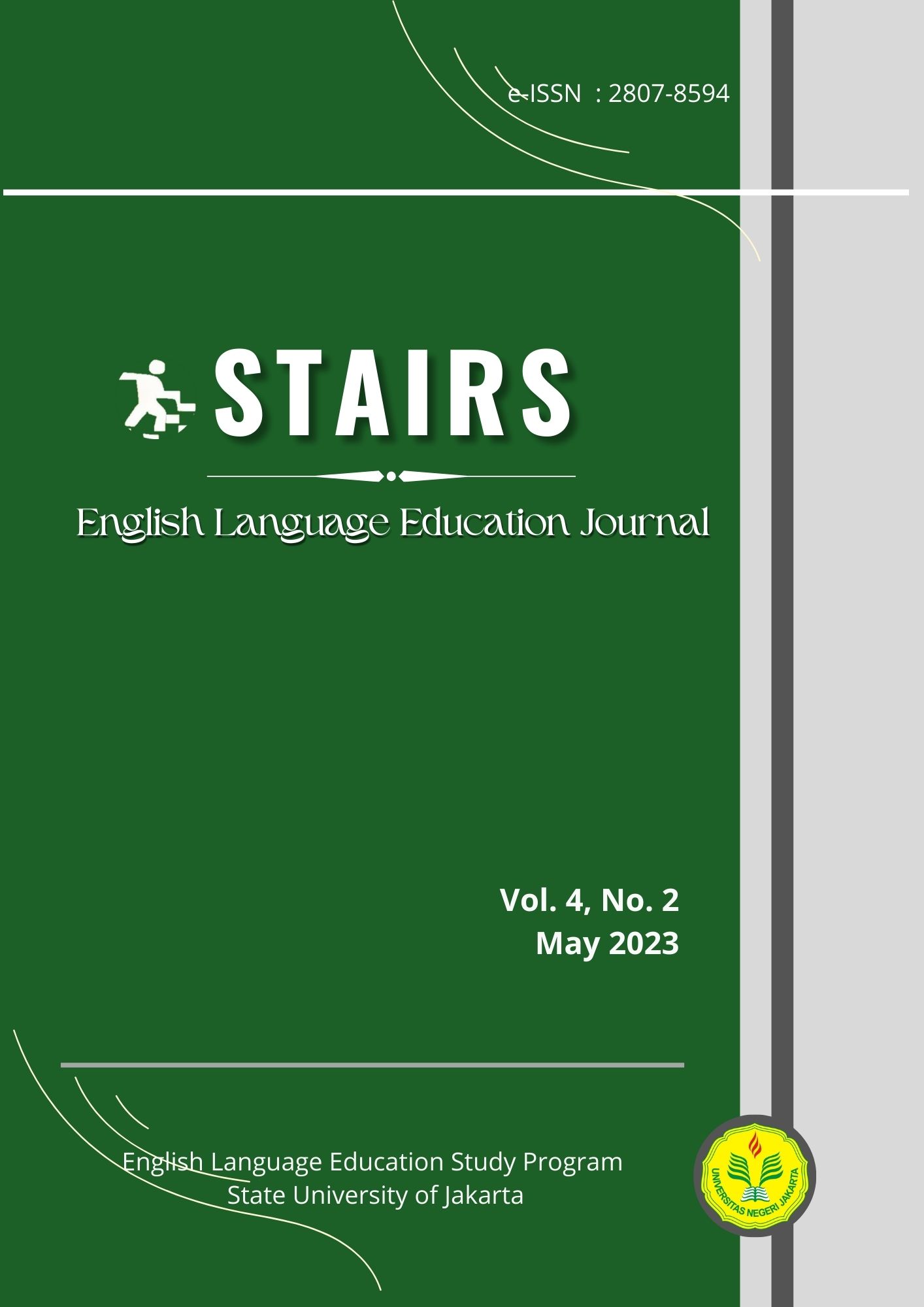Student Engagement in Flipped English Classrooms: A Case Study of General English for Adults in an English Course in Jakarta
DOI:
https://doi.org/10.21009/stairs.4.2.3Keywords:
Collaborative group work, English learning, Flipped learning, Pre-class materials, Student engagementAbstract
This research investigates the influence of flipped learning on the engagement of adult participants in non-formal English language programs, considering diverse language proficiency levels. Employing a comprehensive methodology involving observations, interviews, and surveys, the study assesses engagement indicators and captures participants' perspectives. The incorporation of pre-class materials emerges as a significant contributor, empowering students to anticipate and prepare for in-person sessions, thereby fostering confidence and active participation in class discussions. The integration of collaborative group work further enhances engagement by introducing diverse viewpoints. Survey findings align with observations and interviews, affirming the effectiveness of the flipped learning model in augmenting student engagement. The approach also positively impacts students' perceptions of English learning, encouraging a deeper exploration of its practical relevance. This study highlights the crucial role of flipped learning in fostering dynamic and meaningful student engagement, offering valuable insights for educators seeking to optimize their teaching methodologies. Acknowledging limitations in sample size and educational context, the research emphasizes the necessity for future studies in more diverse settings.
References
Akçayır, G., & Akçayır, M. (2018). The Flipped Classroom: A Review of its Advantages and Challenges. Computers & Education, 126, 334–345.
Ansori, M., & Nafi', N. N. (2018). English Teachers' Perceived Benefits and Challenges of Flipped Classroom Implementation. JEELS (Journal of English Education and Linguistics Studies), 5(2), 211–227. https://doi.org/10.30762/jeels.v5i2.820
Baxter, P., & Jack, S. (2008). Qualitative Case Study Methodology: Study Design and Implementation for Novice Researchers. The Qualitative Report, 13, 544–559.
Bishop, J., & Verleger, M. (2013). The Flipped Classroom: A Survey of the Research. Proceedings of the 120th ASEE Annual Conference & Exposition. Retrieved from http://www.asee.org/public/conferences/20/papers/6219/download
Bond, M. (2019). Flipped Learning and Parent Engagement in Secondary Schools: A South Australian case study. British Journal of Educational Technology, 50(3), 1294–1319. https://doi.org/10.1111/bjet.12765.
Bond, M., Buntins, K., Bedenlier, S., Zawacki-Richter, O., & Kerres, M. (2020). Mapping Research in Student Engagement and Educational Technology in Higher Education: A Systematic Evidence Map. International Journal of Educational Technology in Higher Education, 17(1), 1–30. https://doi.org/10.1186/s41239-019-0176-8.
Brewer, R., & Movahedazarhouligh, S. (2018). Successful Stories and Conflicts: A Literature Review on the Effectiveness of Flipped Learning in Higher Education. Journal of Computer Assisted Learning, 34(4), 409–416. doi:10.1111/jcal.12250
Finn, J. (2006). The Adult Lives of At-risk Students: The Roles of Attainment and Engagement in High School (NCES 2006-328). Washington, DC: U.S. Department of Education, National Center for Education Statistics website. Retrieved from https://nces.ed.gov/pubs2006/2006328.pdf.
Francl, T. J. (2014). Is Flipped Learning Appropriate? Journal of Research in Innovative Teaching, 71, 119-128.
Johnson, G. B. (2013). Student Perceptions of the Flipped Classroom. Columbia: The University Of British Columbia.
Kaarbo, J., & Beasley, R. K. (1999). A Practical Guide to the Comparative Case Study Method in Political Psychology. Political Psychology, 20, 369–391.
Kuh, G. D., Cruce, T. M., Shoup, R., Kinzie, J., & Gonyea, R. M. (2008). Unmasking the Effects of Student Engagement on First-year College Grades and Persistence. The Journal of Higher Education, 79(5), 540–563.
Purnawan, S. (2015). Upaya Meningkatkan Keaktifan Siswa Melalui Penerapan Model Pembelajaran Flipped Classroom dengan Media E-Book pada pembelajaran KKPI Kelas XI Multimedia SMK Negeri Jumo Temanggung. Skripsi. Universitas Kristen Satya Wacana. Salatiga.
Roehl, A., Reddy, S. L., & Shannon, G. J. (2013). The Flipped Classroom: An Opportunity to Engage Millennial Students through Active Learning Strategies. Texas: Christian University Journal of Family & Consumer Sciences.
Steen-Utheim, A. T., & Foldnes, N. (2017). A Qualitative Investigation of Student Engagement in a Flipped Classroom. Teaching in Higher Education, 23(3), 307–324. doi:10.1080/13562517.2017.1379481
Sudjana, N. (2010). Penilaian Hasil Proses Belajar Mengajar. Bandung: Remaja Rosdakarya.
Sunarto. (2012). Icebreaker Dalam Pembelajaran Aktif. Surakarta: Cakrawala Media.
Teng, M. F. (2017). Flipping the Classroom and Tertiary Level EFL Students' Academic Performance and Satisfaction. Journal of Asia TEFL, 14(4), 605–620. https://doi.org/10.18823/asiatefl.2017.14.4.2.605



